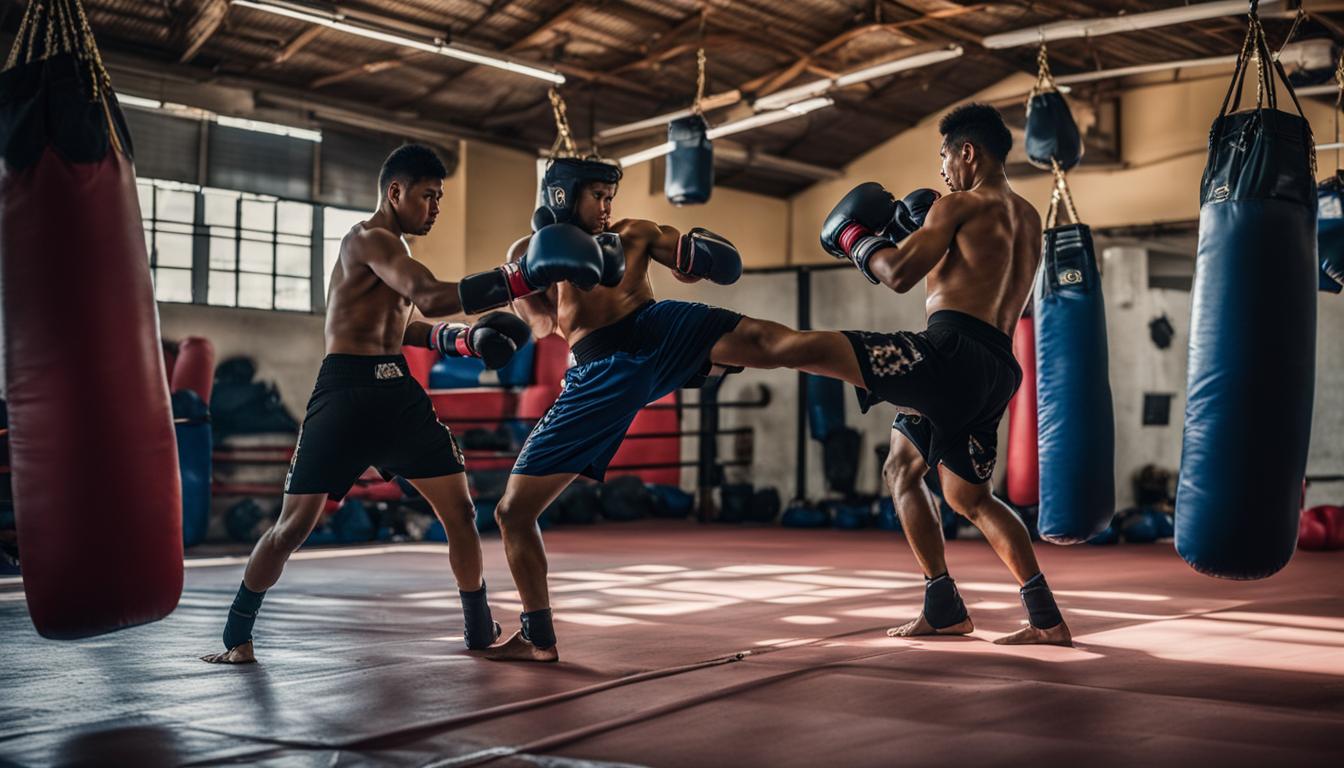Are you ready to embark on an exciting journey into the world of Muay Thai? Look no further – this complete guide will provide everything you need to know about Muay Thai training programs. Whether you’re a beginner or have previous martial arts experience, this guide will equip you with the knowledge and skills to kickstart your Muay Thai training.
Muay Thai, also known as the “Art of Eight Limbs,” is a highly effective striking discipline that utilizes various strikes and techniques. This comprehensive guide will start from the basics, covering the essential stances and footwork. From there, we’ll delve into the different punches, kicks, knee strikes, elbow strikes, and clinching techniques that make Muay Thai so formidable.
Not only will you learn the technical aspects of Muay Thai, but you’ll also discover the importance of defense techniques to protect yourself during training and fights. Additionally, we’ll explore the different styles of Muay Thai, allowing you to find your own unique approach to this martial art.
Key Takeaways:
- Muay Thai training programs provide a comprehensive approach to learning the art of Muay Thai.
- Basic stances and footwork are crucial foundations for effective Muay Thai techniques.
- Punches, kicks, knee strikes, elbow strikes, and clinching techniques are essential components of Muay Thai.
- Defense techniques play a vital role in minimizing damage and creating opportunities for counterattacks.
- Various styles of Muay Thai offer different approaches to the martial art, allowing practitioners to find their preferred style.
The Importance of a Strong Stance and Footwork in Muay Thai
A strong stance and proper footwork are fundamental in the art of Muay Thai. The effectiveness of your strikes and overall performance greatly depends on these foundational elements. In this section, we will explore the significance of a strong stance and footwork in Muay Thai and how they contribute to your success inside the ring.
First and foremost, the Muay Thai stance provides a solid foundation for balance and stability. It involves positioning your feet shoulder-width apart, with your lead foot slightly angled outward and your rear foot turned slightly inward. This stance allows for quick pivoting and swift movements while maintaining a strong base.
Proper footwork is vital in Muay Thai as it enables you to generate power, evade attacks, and set up your own strikes. The footwork techniques in Muay Thai include stepping forward, backward, sideways, and pivoting. These movements allow you to maintain control over your positioning and create opportunities for effective offensive and defensive maneuvers.
“Footwork is the key to unlocking the true potential of your strikes in Muay Thai. It allows you to transfer weight efficiently, generate maximum power, and maintain balance throughout your techniques.” – Muay Thai Master
Mastering the Muay Thai stance and footwork involves practice, discipline, and an understanding of how these elements work in harmony. By honing your footwork skills, you can effectively control the distance between yourself and your opponent, create angles for strikes, and seamlessly transition between offensive and defensive actions.
The Benefits of a Strong Stance and Footwork in Muay Thai
| Benefits | Description |
|---|---|
| Enhanced balance and stability | A strong stance provides a solid foundation, allowing you to maintain balance and stability throughout your techniques. |
| Efficient weight transfer | Proper footwork facilitates the transfer of weight, enabling you to generate maximum power in your strikes. |
| Improved agility and speed | Effective footwork techniques allow for quick movements, agility, and the ability to evade and counter your opponent’s attacks. |
| Control over distance | Mastering footwork enables you to control the distance between you and your opponent, allowing you to create openings for strikes and maintain a tactical advantage. |
Mastering the Essential Punches in Muay Thai
Punches play a crucial role in Muay Thai, setting up combinations and creating openings for other strikes. One of the most important punches for beginners to master in Muay Thai is the jab. The jab is a versatile and effective punch that can disrupt your opponent’s rhythm and create opportunities for further attacks.
To execute a powerful jab, proper technique and body mechanics are essential. Start by standing in your Muay Thai stance, with your feet shoulder-width apart and your lead foot slightly turned out. As you throw the jab, extend your lead hand straight forward, rotating your shoulder and hip for added power.
Remember to keep your other hand guarding your face and your body balanced throughout the movement. Practice your jab repeatedly, focusing on speed, accuracy, and snap. As you become more proficient, you can start incorporating the jab into combinations, using it to set up hooks, uppercuts, or follow-up kicks.
Mastering the Jab: Key Points
- Start from your Muay Thai stance, with feet shoulder-width apart.
- Extend your lead hand straight forward, rotating your shoulder and hip for power.
- Keep your other hand guarding your face and maintain balance in your body.
- Focus on speed, accuracy, and snap in your jab.
- Incorporate the jab into combinations to create openings for other strikes.
With consistent practice and refinement, the jab will become a powerful tool in your Muay Thai arsenal, allowing you to control the distance, break your opponent’s defense, and launch devastating attacks.
| Punch | Description | Technique |
|---|---|---|
| Jab | A quick, straight punch thrown with the lead hand. | Extend the lead hand straight forward, rotating the shoulder and hip for power. |
| Cross | A powerful punch thrown with the rear hand, crossing the body. | Pivot the back foot and rotate the shoulder and hip as you throw the punch. |
| Hook | A punch thrown in a looping motion to the side of the opponent’s head or body. | Twist the hips and pivot the lead foot as you swing your arm in a horizontal arc. |
| Uppercut | An upward punch targeting the chin or body of the opponent. | Bend the knees and drive the lead hand upward in a vertical motion. |
By mastering these essential punches in Muay Thai, you will have a solid foundation for further developing your striking skills. Remember to always train under the guidance of a qualified instructor and prioritize safety during your training sessions. Keep practicing, refining your technique, and exploring new combinations to continuously improve your Muay Thai skills.
Unleashing Powerful Kicks in Muay Thai
Muay Thai is renowned for its devastating kicks, which utilize the shins as a powerful weapon. One of the most common and powerful kicks in Muay Thai is the roundhouse kick. This section will guide you through the fundamental techniques and mechanics needed to execute a roundhouse kick with precision and power.
To start, position yourself in a proper Muay Thai stance, with your feet shoulder-width apart and your lead foot slightly turned outward. As you throw the roundhouse kick, pivot on the balls of your supporting foot, generating rotational force from the hips. This hip rotation is crucial for generating maximum power and speed in your kick.
As you swing your leg, aim to strike with the lower part of your shin, just below the knee. This area has a dense concentration of bone and will deliver a strong impact. Remember to keep your toes flexed and your foot turned outward, ensuring a solid and effective strike.
Practice the roundhouse kick on a heavy bag or with a partner holding pads, focusing on accuracy, speed, and power. The more you refine your technique, the more devastating your kicks will become in a real fighting situation. So, unleash the power of Muay Thai kicks by mastering the roundhouse kick and incorporating it into your training routine.
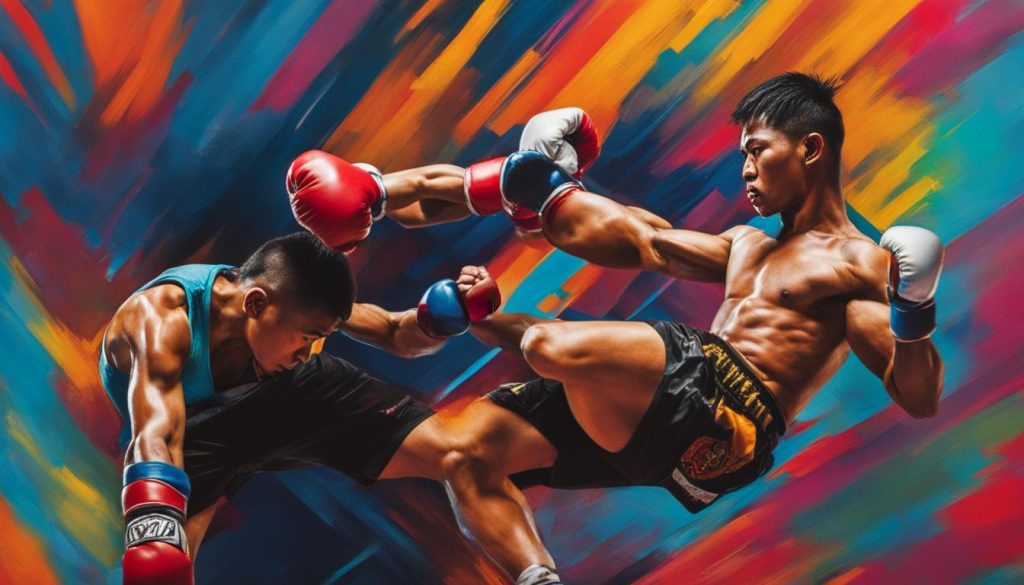
Dominating with Push Kicks in Muay Thai
The push kick, also known as the teep, is a versatile and effective strike in Muay Thai. It is a front-footed push that can be used to maintain distance, disrupt your opponent’s balance, and set up other strikes. The teep is executed by extending the leg straight forward, driving the ball of the foot into the target.
The push kick is one of the most powerful weapons in a Muay Thai practitioner’s arsenal. It allows you to keep your opponent at bay, creating space and preventing them from closing the distance. This makes it particularly effective against aggressive opponents or those who rely heavily on close-range attacks.
To execute a push kick with maximum effect, proper technique is crucial. Start by standing in your fighting stance, with your hands up and your weight evenly distributed. As you extend your leg, pivot on the supporting foot, rotating your hips and driving the push kick forward. Aim for the abdomen or chest area, where it can generate the most impact.
Practice and repetition are key to mastering the push kick. Drill the technique until it becomes second nature, focusing on accuracy, speed, and power. Incorporate it into your training sessions, both in shadowboxing and in sparring, to develop the timing and distance control needed to fully utilize the push kick in a real fight. Remember, the push kick is not just a defensive tool, but also a powerful offensive weapon that can turn the tide of a fight in your favor.
| Benefits of Push Kicks in Muay Thai | Technique | Tips |
|---|---|---|
| Creates distance | Extend the leg straight forward, driving the ball of the foot into the target | Focus on accuracy, speed, and power during practice |
| Disrupts opponent’s balance | Pivot on the supporting foot, rotate hips, and drive the push kick forward | Incorporate push kicks in shadowboxing and sparring for timing and distance control |
| Sets up other strikes | Aim for the abdomen or chest area for maximum impact | Drill the technique until it becomes second nature |
Inflict Devastating Damage with Knee Strikes in Muay Thai
Knee strikes are a signature weapon of Muay Thai and can cause devastating damage to your opponents. The effectiveness of knee strikes lies in their ability to deliver powerful blows to vulnerable areas of the body, such as the torso and head. Proper technique and timing are essential for executing knee strikes with precision and force.
When executing knee strikes, it is important to generate power from your hips by driving them forward. This hip thrust, combined with the forward motion of your entire body, adds significant force to the strike. To maximize the impact, aim to make contact with the bony part of your knee, which can cause severe pain and injury to your opponent.
The clinch is a position where knee strikes can be particularly devastating. By controlling your opponent’s neck or arms in the clinch, you can effectively deliver a barrage of knee strikes to their body. The clinch also allows for knee strikes to the head, which can be a fight-ending technique when executed with precision and power.
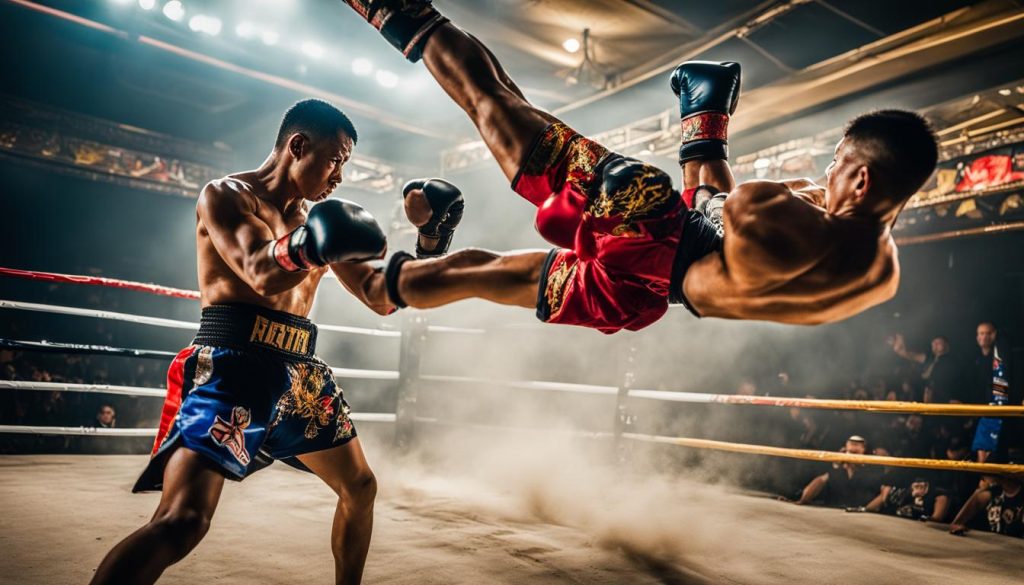
It is worth noting that knee strikes in the clinch require a good sense of balance and control. You should focus on maintaining stability while delivering knee strikes, as your opponent may try to off-balance you or counter with strikes of their own.
Overall, knee strikes are a formidable weapon in the arsenal of a Muay Thai practitioner. When executed correctly, they can deliver devastating damage and potentially end a fight. However, it is crucial to train under the guidance of a qualified instructor to ensure proper technique and minimize the risk of injury to yourself or your training partners.
Mastering the Art of Elbow Strikes in Muay Thai
Elbow strikes are a signature weapon in Muay Thai, known for their devastating power and ability to cause serious damage to opponents. Mastering the art of elbow strikes is essential for any practitioner looking to excel in this martial art. There are several different types of elbow strikes in Muay Thai, each with its own technique and application.
Horizontal Elbow (Sok Ti)
The horizontal elbow, also known as Sok Ti, is a powerful strike that is executed horizontally, aiming to hit the opponent with the sharp point of the elbow. This strike is most effective at close range and can be used in the clinch or during exchanges.
To execute the horizontal elbow, rotate your hips and shoulders while keeping your arm relaxed. As you rotate, bring your elbow across your body and drive it forward with force, aiming to strike your opponent’s head, face, or body.
“The horizontal elbow is one of the most devastating strikes in Muay Thai. Its power comes from the rotation of the entire body, generating tremendous force and impact.”
Vertical Elbow (Sok Ngat)
The vertical elbow, also known as Sok Ngat, is an upward strike that targets the opponent’s chin, jaw, or body. This strike is commonly used to counter an incoming attack or to break an opponent’s guard.
To execute the vertical elbow, start with your arm close to your body and your palm facing downward. Drive your elbow upward in a swift motion, rotating your hips and shoulders to generate power. Aim to strike with the bony part of your elbow, maximizing the impact.
Descending Elbow (Sok Chieng)
The descending elbow, or Sok Chieng, is a downward strike that is effective for attacking the top of an opponent’s head or targeting their collarbone. This strike is powerful and can cause significant damage if executed correctly.
To execute the descending elbow, raise your arm above your head, keeping your elbow pointed straight down. Drive your elbow downward with force, aiming to strike your opponent’s target area. As with other elbow strikes, the rotation of your hips and shoulders is crucial for generating power.
Mastering the art of elbow strikes in Muay Thai requires dedicated practice and proper technique. By understanding the different types of elbow strikes and their applications, you can effectively incorporate them into your arsenal, enhancing your striking abilities and increasing your chances of success in the ring.
Mastering the Clinch in Muay Thai
The clinch is a fundamental aspect of Muay Thai that allows fighters to control their opponents, unleash devastating strikes, and dictate the flow of the fight. Understanding the intricacies and techniques of the clinch is essential for any practitioner looking to take their skills to the next level.
When engaging in the clinch, fighters must focus on establishing a strong base and maintaining good posture. This involves keeping the feet shoulder-width apart, knees slightly bent, and maintaining a straight back. By doing so, fighters are able to effectively distribute their weight, stabilize themselves, and generate power from their core.
Once in the clinch, fighters have a range of techniques at their disposal. Common techniques include knee strikes, sweeps, and off-balancing maneuvers. The key to executing these techniques effectively lies in timing, leverage, and proper positioning. By controlling the opponent’s head, neck, and arms, fighters can limit their opponent’s mobility and create opportunities to land devastating strikes.
It is important to note that the clinch requires a high level of physical conditioning, as it can be physically demanding and energy-intensive. Regular training and conditioning exercises specific to the clinch, such as neck strengthening and grip training, can help fighters develop the necessary strength and endurance to excel in this aspect of Muay Thai.
| Benefits of Mastering the Clinch in Muay Thai |
|---|
| – Control and dominance over opponents |
| – Ability to deliver powerful knee strikes |
| – Off-balancing and sweeping techniques |
| – Limited opponent’s mobility and striking ability |
| – Increased physical conditioning and endurance |
Defense Techniques in Muay Thai
Defense is a crucial aspect of Muay Thai that can make the difference between victory and defeat. Knowing how to effectively block, parry, and evade strikes is essential for protecting yourself and minimizing damage during a fight. In this section, we will explore some of the key defense techniques used in Muay Thai, providing you with the knowledge to guard yourself against your opponent’s attacks.
Blocking Techniques
One of the primary defense techniques in Muay Thai is blocking. By using your arms and legs to shield against incoming strikes, you can absorb and minimize the impact of your opponent’s attacks. There are various blocking techniques used in Muay Thai, including:
- High Block: This technique involves raising your forearm to protect your head and face against high-level strikes, such as hooks or uppercuts.
- Low Block: To defend against low kicks or knee strikes, you can lower your shin or forearm to block the incoming attack.
- Body Block: By tightening your core and bringing your elbows together, you can create a solid defense against strikes aimed at your midsection.
Mastering these blocking techniques requires precision, timing, and proper positioning. Regular practice and sparring sessions will help you develop the necessary skills to effectively defend yourself in the ring.
Parrying and Evading Strikes
In addition to blocking, Muay Thai also emphasizes the use of parrying and evading techniques to avoid incoming strikes altogether. By using precise movements and footwork, you can redirect or completely evade your opponent’s attacks. Some common parrying and evading techniques include:
- Parry: This technique involves redirecting your opponent’s strike off to the side, using your forearm or hand to create a barrier.
- Slip: By utilizing head movement, you can slip past your opponent’s punches, avoiding contact while maintaining your balance and position.
- Bob and Weave: This technique involves bending at the knees and waist, allowing punches to pass over your head or body.
The ability to parry and evade strikes requires agility, anticipation, and timing. Regular practice of these techniques will enhance your defensive skills and make you a more elusive and difficult target for your opponents.
| Defense Technique | Description |
|---|---|
| High Block | Raises forearm to protect the head and face against high-level strikes. |
| Low Block | Lowers shin or forearm to defend against low kicks or knee strikes. |
| Body Block | Tightens core and brings elbows together to defend against strikes aimed at the midsection. |
| Parry | Redirects opponent’s strike off to the side, using forearm or hand as a barrier. |
| Slip | Utilizes head movement to slip past opponent’s punches, avoiding contact. |
| Bob and Weave | Bends at the knees and waist to allow punches to pass over the head or body. |
By incorporating these defense techniques into your Muay Thai training, you will become a more well-rounded fighter, capable of both offensive attacks and defensive maneuvers. Remember that effective defense is not only about protecting yourself but also creating opportunities for counterattacks to gain the upper hand in the fight.
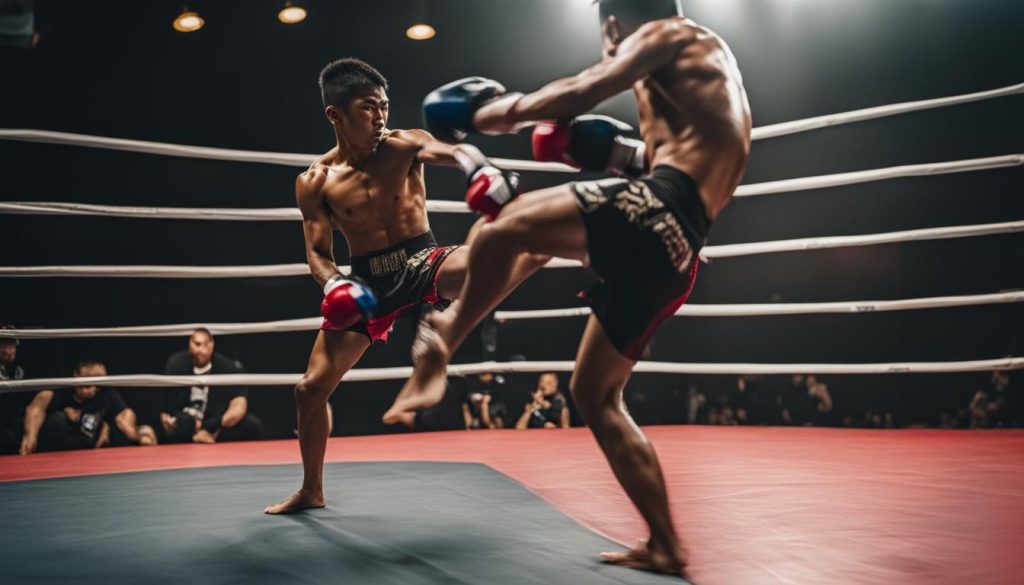
With consistent practice and a solid foundation in defense, you will be better equipped to handle the challenges of a Muay Thai fight. Stay focused, disciplined, and always prioritize the development of your defensive skills to become a well-rounded and formidable practitioner of this ancient martial art.
Exploring the Different Styles of Muay Thai
Muay Thai, also known as the “Art of Eight Limbs,” encompasses various styles and approaches to the martial art. Each style has its own unique characteristics, training methods, and strategic focus. In this section, we will explore some of the traditional Muay Thai styles and techniques that have evolved over the centuries.
1. Muay Mat Style
The Muay Mat style is characterized by its aggressive and relentless approach. Fighters who adopt this style are known for their heavy punches, powerful kicks, and a high level of aggression. The emphasis is on overwhelming the opponent with relentless attacks and raw power. Muay Mat fighters excel at close-quarter combat, utilizing strong clinching techniques and devastating knee strikes. This style requires a high level of physical conditioning and mental toughness.
2. Muay Femur Style
The Muay Femur style is known for its technical precision, finesse, and exceptional timing. Fighters who embrace this style focus on maintaining distance, using angles to create openings, and executing strikes with precision and accuracy. Muay Femur fighters emphasize fluid movement, footwork, and counterattacking strategies. This style requires a deep understanding of timing, feints, and defensive techniques to exploit the opponent’s vulnerabilities.
It’s important to note that these are just two examples of the many styles within Muay Thai. There are also regional variations and individual adaptations that contribute to the diversity of this martial art. Exploring these different styles allows practitioners to develop a well-rounded understanding of Muay Thai and adapt their training to match their own strengths and preferences.
By studying the traditional techniques associated with each style, practitioners can gain insights into the strategic choices made by fighters throughout history. This knowledge can inform their own training and help them refine their skills in specific areas. Whether one chooses to adopt the aggressive Muay Mat style or the technical finesse of the Muay Femur style, the ultimate goal remains the same: to master the art of Muay Thai and become a skilled and formidable practitioner.
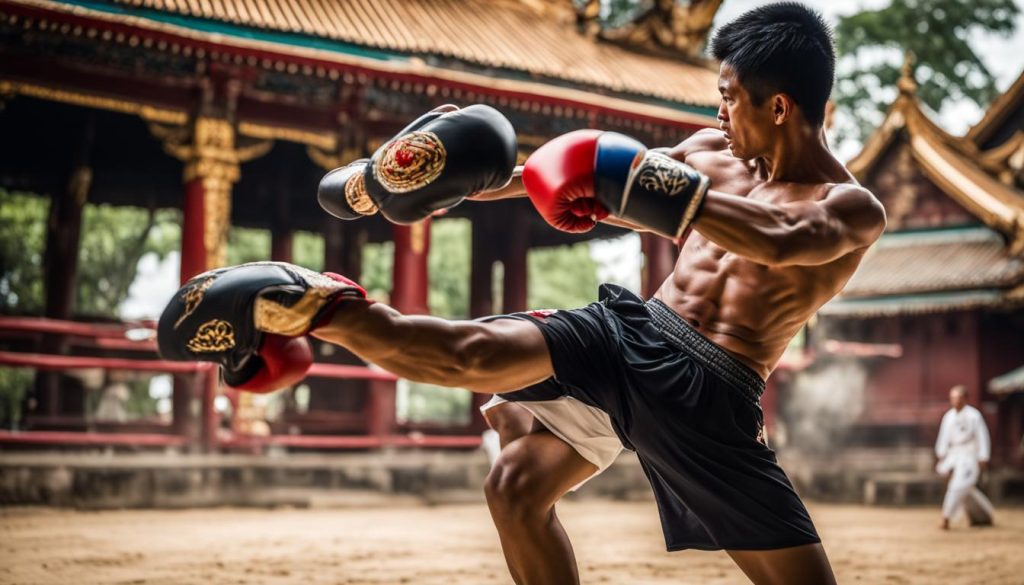
Conclusion
As you reach the end of this comprehensive guide, you now have a solid understanding of Muay Thai and its training programs. From mastering the essential techniques to exploring different styles, you have gained valuable insights into this dynamic martial art.
Remember, a journey in Muay Thai is a continuous process. Whether you are a beginner or an experienced practitioner, there is always room for improvement. Keep practicing and refining your techniques to achieve mastery in this exhilarating discipline.
While this guide has provided you with a strong foundation, it is important to seek guidance from qualified instructors and trainers to ensure you progress safely and effectively in your Muay Thai journey. By dedicating yourself to regular training and pushing your limits, you can unlock your full potential in this ancient art form.
Embrace the challenges, embrace the discipline, and let Muay Thai transform not only your physical fitness but also your mental strength and self-confidence. With the knowledge you have gained, you are now equipped to embark on your Muay Thai training program and make significant strides towards achieving your goals. Good luck!
FAQ
What is Muay Thai?
Muay Thai, also known as the “Art of Eight Limbs,” is a striking discipline that utilizes punches, kicks, knees, and elbows.
What is the importance of a strong stance and footwork in Muay Thai?
A strong stance and proper footwork are essential foundations for a Muay Thai fighter. They provide balance, generate power, and allow for effective execution of techniques.
What are some of the essential punches in Muay Thai?
The jab is one of the most important punches to master in Muay Thai. It sets up combinations and disrupts opponent’s rhythm, creating openings for other strikes.
How do you unleash powerful kicks in Muay Thai?
Muay Thai is renowned for its devastating kicks. The roundhouse kick is a fundamental technique that requires proper technique, hip rotation, and weight transfer for maximum power.
How are push kicks utilized in Muay Thai?
Push kicks, or teeps, are versatile strikes used to maintain distance, disrupt opponent’s balance, and set up other strikes. Generating power, accuracy, and control are essential for effective push kicks.
How can knee strikes cause devastating damage in Muay Thai?
Knee strikes are signature weapons in Muay Thai and can cause severe damage to opponents. Proper technique, power generation, and utilization of the clinch are key for delivering devastating knee strikes.
What makes elbow strikes lethal in Muay Thai?
Elbow strikes in Muay Thai are powerful and capable of causing severe damage to opponents. Understanding the different types of elbow strikes and mastering their technique is essential for utilizing this devastating technique effectively.
What is the clinch in Muay Thai?
The clinch is a unique aspect of Muay Thai that involves close-quarter grappling. It allows for control, off-balancing, and striking from a clinched position, setting Muay Thai apart from other striking disciplines.
What are some essential defense techniques in Muay Thai?
Blocking, parrying, and evading strikes are essential defensive techniques in Muay Thai. They allow you to protect yourself effectively while maintaining good balance and positioning.
What are the different styles of Muay Thai?
Muay Thai encompasses various styles, including the aggressive “Muay Mat” style and the technical “Muay Femur” style. Understanding the nuances and characteristics of each style can help you determine your preferred approach and expand your knowledge of the art.
Source Links
- https://evolve-mma.com/blog/the-complete-muay-thai-beginners-guide/
- https://www.ronintrainingcenter.com/post/muay-thai-training-guide-for-beginners
- https://www.barnesandnoble.com/w/muay-thai-training-exercises-christoph-delp/1116321434
Last modified: December 1, 2023

